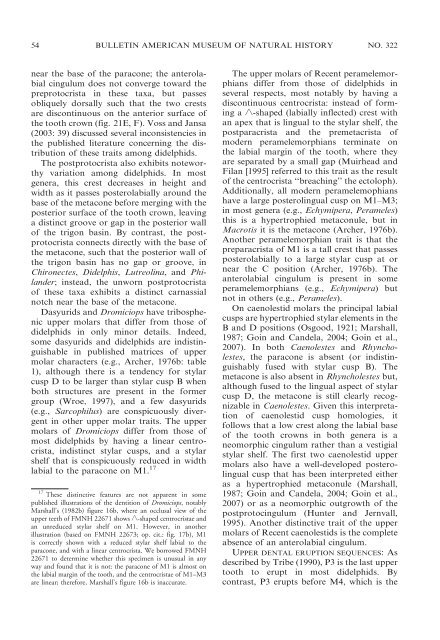phylogenetic relationships and classification of didelphid marsupials ...
phylogenetic relationships and classification of didelphid marsupials ...
phylogenetic relationships and classification of didelphid marsupials ...
Create successful ePaper yourself
Turn your PDF publications into a flip-book with our unique Google optimized e-Paper software.
54 BULLETIN AMERICAN MUSEUM OF NATURAL HISTORY NO. 322<br />
near the base <strong>of</strong> the paracone; the anterolabial<br />
cingulum does not converge toward the<br />
preprotocrista in these taxa, but passes<br />
obliquely dorsally such that the two crests<br />
are discontinuous on the anterior surface <strong>of</strong><br />
the tooth crown (fig. 21E, F). Voss <strong>and</strong> Jansa<br />
(2003: 39) discussed several inconsistencies in<br />
the published literature concerning the distribution<br />
<strong>of</strong> these traits among <strong>didelphid</strong>s.<br />
The postprotocrista also exhibits noteworthy<br />
variation among <strong>didelphid</strong>s. In most<br />
genera, this crest decreases in height <strong>and</strong><br />
width as it passes posterolabially around the<br />
base <strong>of</strong> the metacone before merging with the<br />
posterior surface <strong>of</strong> the tooth crown, leaving<br />
a distinct groove or gap in the posterior wall<br />
<strong>of</strong> the trigon basin. By contrast, the postprotocrista<br />
connects directly with the base <strong>of</strong><br />
the metacone, such that the posterior wall <strong>of</strong><br />
the trigon basin has no gap or groove, in<br />
Chironectes, Didelphis, Lutreolina, <strong>and</strong> Phil<strong>and</strong>er;<br />
instead, the unworn postprotocrista<br />
<strong>of</strong> these taxa exhibits a distinct carnassial<br />
notch near the base <strong>of</strong> the metacone.<br />
Dasyurids <strong>and</strong> Dromiciops have tribosphenic<br />
upper molars that differ from those <strong>of</strong><br />
<strong>didelphid</strong>s in only minor details. Indeed,<br />
some dasyurids <strong>and</strong> <strong>didelphid</strong>s are indistinguishable<br />
in published matrices <strong>of</strong> upper<br />
molar characters (e.g., Archer, 1976b: table<br />
1), although there is a tendency for stylar<br />
cusp D to be larger than stylar cusp B when<br />
both structures are present in the former<br />
group (Wroe, 1997), <strong>and</strong> a few dasyurids<br />
(e.g., Sarcophilus) are conspicuously divergent<br />
in other upper molar traits. The upper<br />
molars <strong>of</strong> Dromiciops differ from those <strong>of</strong><br />
most <strong>didelphid</strong>s by having a linear centrocrista,<br />
indistinct stylar cusps, <strong>and</strong> a stylar<br />
shelf that is conspicuously reduced in width<br />
labial to the paracone on M1. 17<br />
17 These distinctive features are not apparent in some<br />
published illustrations <strong>of</strong> the dentition <strong>of</strong> Dromiciops, notably<br />
Marshall’s (1982b) figure 16b, where an occlusal view <strong>of</strong> the<br />
upper teeth <strong>of</strong> FMNH 22671 shows ‘-shaped centrocristae <strong>and</strong><br />
an unreduced stylar shelf on M1. However, in another<br />
illustration (based on FMNH 22673; op. cit.: fig. 17b), M1<br />
is correctly shown with a reduced stylar shelf labial to the<br />
paracone, <strong>and</strong> with a linear centrocrista. We borrowed FMNH<br />
22671 to determine whether this specimen is unusual in any<br />
way <strong>and</strong> found that it is not: the paracone <strong>of</strong> M1 is almost on<br />
the labial margin <strong>of</strong> the tooth, <strong>and</strong> the centrocristae <strong>of</strong> M1–M3<br />
are linear; therefore, Marshall’s figure 16b is inaccurate.<br />
The upper molars <strong>of</strong> Recent peramelemorphians<br />
differ from those <strong>of</strong> <strong>didelphid</strong>s in<br />
several respects, most notably by having a<br />
discontinuous centrocrista: instead <strong>of</strong> forming<br />
a ‘-shaped (labially inflected) crest with<br />
an apex that is lingual to the stylar shelf, the<br />
postparacrista <strong>and</strong> the premetacrista <strong>of</strong><br />
modern peramelemorphians terminate on<br />
the labial margin <strong>of</strong> the tooth, where they<br />
are separated by a small gap (Muirhead <strong>and</strong><br />
Filan [1995] referred to this trait as the result<br />
<strong>of</strong> the centrocrista ‘‘breaching’’ the ectoloph).<br />
Additionally, all modern peramelemophians<br />
have a large posterolingual cusp on M1–M3;<br />
in most genera (e.g., Echymipera, Perameles)<br />
this is a hypertrophied metaconule, but in<br />
Macrotis it is the metacone (Archer, 1976b).<br />
Another peramelemorphian trait is that the<br />
preparacrista <strong>of</strong> M1 is a tall crest that passes<br />
posterolabially to a large stylar cusp at or<br />
near the C position (Archer, 1976b). The<br />
anterolabial cingulum is present in some<br />
peramelemorphians (e.g., Echymipera) but<br />
not in others (e.g., Perameles).<br />
On caenolestid molars the principal labial<br />
cusps are hypertrophied stylar elements in the<br />
B <strong>and</strong> D positions (Osgood, 1921; Marshall,<br />
1987; Goin <strong>and</strong> C<strong>and</strong>ela, 2004; Goin et al.,<br />
2007). In both Caenolestes <strong>and</strong> Rhyncholestes,<br />
the paracone is absent (or indistinguishably<br />
fused with stylar cusp B). The<br />
metacone is also absent in Rhyncholestes but,<br />
although fused to the lingual aspect <strong>of</strong> stylar<br />
cusp D, the metacone is still clearly recognizable<br />
in Caenolestes. Given this interpretation<br />
<strong>of</strong> caenolestid cusp homologies, it<br />
follows that a low crest along the labial base<br />
<strong>of</strong> the tooth crowns in both genera is a<br />
neomorphic cingulum rather than a vestigial<br />
stylar shelf. The first two caenolestid upper<br />
molars also have a well-developed posterolingual<br />
cusp that has been interpreted either<br />
as a hypertrophied metaconule (Marshall,<br />
1987; Goin <strong>and</strong> C<strong>and</strong>ela, 2004; Goin et al.,<br />
2007) or as a neomorphic outgrowth <strong>of</strong> the<br />
postprotocingulum (Hunter <strong>and</strong> Jernvall,<br />
1995). Another distinctive trait <strong>of</strong> the upper<br />
molars <strong>of</strong> Recent caenolestids is the complete<br />
absence <strong>of</strong> an anterolabial cingulum.<br />
UPPER DENTAL ERUPTION SEQUENCES: As<br />
described by Tribe (1990), P3 is the last upper<br />
tooth to erupt in most <strong>didelphid</strong>s. By<br />
contrast, P3 erupts before M4, which is the

















